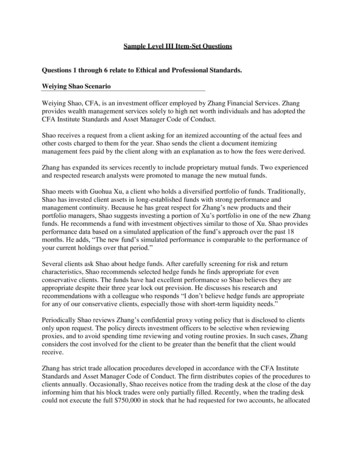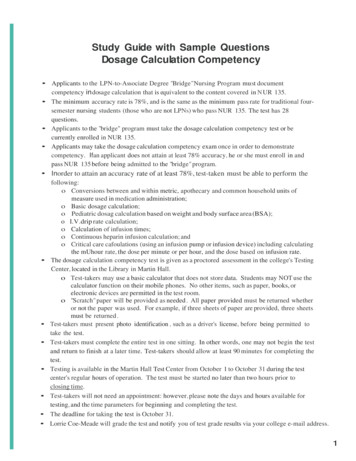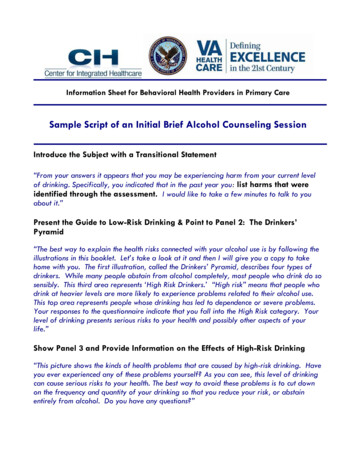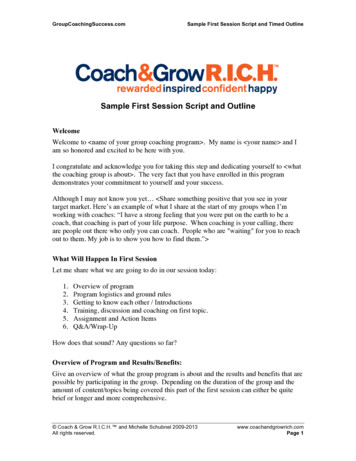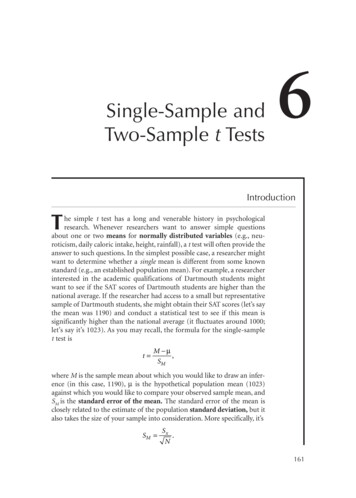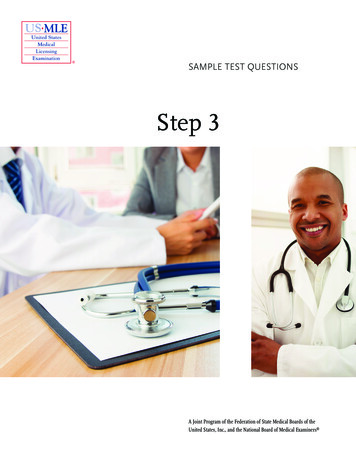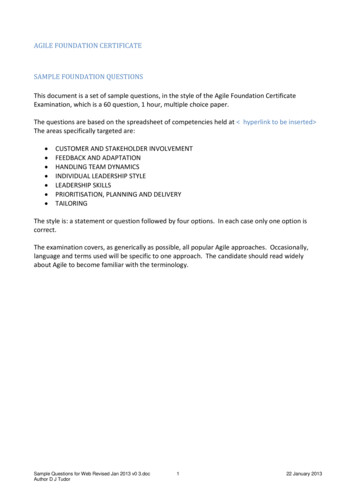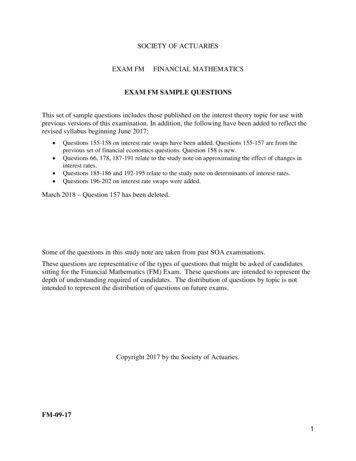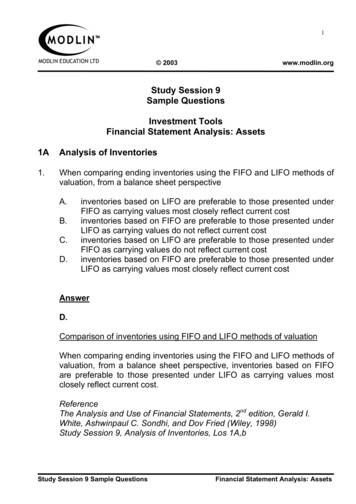
Transcription
1 2003www.modlin.orgStudy Session 9Sample QuestionsInvestment ToolsFinancial Statement Analysis: Assets1AAnalysis of Inventories1.When comparing ending inventories using the FIFO and LIFO methods ofvaluation, from a balance sheet perspectiveA.B.C.D.inventories based on LIFO are preferable to those presentedFIFO as carrying values most closely reflect current costinventories based on FIFO are preferable to those presentedLIFO as carrying values do not reflect current costinventories based on LIFO are preferable to those presentedFIFO as carrying values do not reflect current costinventories based on FIFO are preferable to those presentedLIFO as carrying values most closely reflect current costunderunderunderunderAnswerD.Comparison of inventories using FIFO and LIFO methods of valuationWhen comparing ending inventories using the FIFO and LIFO methods ofvaluation, from a balance sheet perspective, inventories based on FIFOare preferable to those presented under LIFO as carrying values mostclosely reflect current cost.ReferenceThe Analysis and Use of Financial Statements, 2nd edition, Gerald I.White, Ashwinpaul C. Sondhi, and Dov Fried (Wiley, 1998)Study Session 9, Analysis of Inventories, Los 1A,bStudy Session 9 Sample QuestionsFinancial Statement Analysis: Assets
2 20032.www.modlin.orgWhen comparing FIFO to LIFO, in periods of rising prices and increasinginventory quantities, the use of LIFO for inventory valuation results inA.B.C.D.the same cash flows regardless of accounting method usedhigher cash flows for LIFO than FIFOhigher cash flows with FIFO perpetual than LIFO periodichigher cash flows for FIFO than LIFOAnswerA.Comparison of FIFO and LIFO in periods of rising pricesWhen comparing FIFO to LIFO, in periods of rising prices and increasinginventory quantities, the use of LIFO for inventory valuation results in thesame cash flows regardless of accounting method used.ReferenceThe Analysis and Use of Financial Statements, 2nd edition, Gerald I.White, Ashwinpaul C. Sondhi, and Dov Fried (Wiley, 1998)Study Session 9, Analysis of Inventories, Los 1A,cUse the following information in answering Questions 3 - 4Assume the 01,400Per unitcost 00Unit sales3003003003001,200Inventory at the beginning of quarter I: 500 units at 25 per unit 12,500Inventory at end of quarter IV: 700 unitsStudy Session 9 Sample QuestionsFinancial Statement Analysis: Assets
3 20033.www.modlin.orgUsing the FIFO method, the reported inventory at the end of the year is:A.B.C.D. 23,000 25,500 35,500 22,474AnswerB.Calculating ending inventory using FIFOUsing the FIFO method, the reported inventory at the end of the year is 25,500Beginning inventory Purchases Cost of goods sold Ending InventoryOpening inventoryPurchasesTotal500 units @ 251,400 units1,900 units 12,500 48,500 61,000Under FIFO, ending inventory consists of 700 units:300 purchased in quarter IV @ 37400 purchased in quarter III @ 36700 units total 11,100 14,400 25,500ReferenceThe Analysis and Use of Financial Statements, 2nd edition, Gerald I.White, Ashwinpaul C. Sondhi, and Dov Fried (Wiley, 1998)Study Session, Analysis of Inventories, Los 1A,aStudy Session 9 Sample QuestionsFinancial Statement Analysis: Assets
4 20034.www.modlin.orgUsing the LIFO method, the reported inventory at the end of the year is:A.B.C.D. 25,500 22,474 23,000 35,500AnswerC.Calculating ending inventory using LIFOUsing the LIFO method, the reported inventory at the end of the year is 23,000Beginning inventory Purchases Cost of goods sold Ending InventoryOpening inventoryPurchasesTotal500 units @ 251,400 units1,900 units 12,500 48,500 61,000Under LIFO, ending inventory consists of 700 units:300 purchased in quarter I @ 30400 purchased in quarter II @ 35700 units total 9,000 14,000 23,000ReferenceThe Analysis and Use of Financial Statements, 2nd edition, Gerald I.White, Ashwinpaul C. Sondhi, and Dov Fried (Wiley, 1998)Study Session, Analysis of Inventories, Los 1A,aStudy Session 9 Sample QuestionsFinancial Statement Analysis: Assets
5 20035.www.modlin.orgThe following information relates to Bex Company: Inventory at the beginning of the accounting period was one unit at 45. Two more units were purchased during the period, the first at 49 andthe second at 53. One unit was sold at 75.Replacement cost at the close of the accounting period was 56.Using the FIFO basis, Bex’s ending inventory is:A.B.C.D. 94 102 100 98AnswerB.Calculating ending inventory using FIFOUsing the FIFO basis, Bex’s ending inventory is 102Ending inventory: 49 53 102ReferenceThe Analysis and Use of Financial Statements, 2nd edition, Gerald I.White, Ashwinpaul C. Sondhi, and Dov Fried (Wiley, 1998)Study Session, Analysis of Inventories, Los 1A,aStudy Session 9 Sample QuestionsFinancial Statement Analysis: Assets
6 2003www.modlin.orgB.Analysis of Long-Lived Assets – Part I1.The accounting treatment of computer software development costs is asfollows:A.B.C.D.all costs incurred to establish the technological and/or economicfeasibility of software are capitalized and once economic feasibilityhas been established, subsequent costs are also capitalizedall costs incurred to establish the technological and/or economicfeasibility of software are expensed as incurred and once economicfeasibility has been established, subsequent costs can becapitalizedall costs incurred to establish the technological and/or economicfeasibility of software are expensed as incurred and once economicfeasibility has been established, subsequent costs are expensedall costs incurred to establish the technological and/or economicfeasibility of software are capitalized as incurred and once economicfeasibility has been established, subsequent costs are expensedAnswerB.The accounting treatment of computer software development costsThe accounting treatment of computer software development costs is asfollows:All costs incurred to establish the technological and/or economicfeasibility of software are expensed as incurred and once economicfeasibility has been established, subsequent costs can be capitalized.ReferenceThe Analysis and Use of Financial Statements, 2nd edition, Gerald I.White, Ashwinpaul C. Sondhi, and Dov Fried (Wiley, 1998)Study Session 9, Analysis of Long-Lived Assets – Part I, Los 1B,cStudy Session 9 Sample QuestionsFinancial Statement Analysis: Assets
7 20032.www.modlin.orgAs compared with expensing costs, the effect of capitalization on a firm’sassets is as follows:A.B.C.D.capitalizing decreases reported assetscapitalizing has no effect on reported assetscapitalizing increases reported assets when there is inflationcapitalizing increases reported assetsAnswerD.The effect of capitalization on a firm’s assetsAs compared with expensing costs, the effect of capitalization on a firm’sassets is an increase in reported assets.ReferenceThe Analysis and Use of Financial Statements, 2nd edition, Gerald I.White, Ashwinpaul C. Sondhi, and Dov Fried (Wiley, 1998)Study Session 9, Analysis of Long-Lived Assets – Part I, Los 1B,aUse the following information in answering Questions 3 - 4Vasco Construction is developing a townhouse complex in New Jersey.The average balance of the “building under construction” account for 20x2was 12 million. Vasco had the following debt outstanding during 20x2( in millions):AverageBalanceInterestRateDevelopment loan 813%Mortgage debt1210Senior debentures5012Study Session 9 Sample QuestionsFinancial Statement Analysis: Assets
8 2003www.modlin.orgAssume that the development loan applies solely to the New Jerseyconstruction:3.The interest payable for 20x2 is:A.B.C.D. 8,240 7,200 7,040 6,000AnswerA.Calculating interest payableThe interest payable for 20x2 is 8,240Debt( 000s)Development 8,000loanMortgage12,000debtDebentures 50,000InterestpayableInterestrate13Interest( 000s)1,040101,200126,0008,240ReferenceThe Analysis and Use of Financial Statements, 2nd edition, Gerald I.White, Ashwinpaul C. Sondhi, and Dov Fried (Wiley, 1998)Study Session 9, Analysis of Long-Lived Assets – Part I, Los 1B,aStudy Session 9 Sample QuestionsFinancial Statement Analysis: Assets
9 20034.www.modlin.orgThe capitalized interest for 20x2 is:A.B.C.D. 8,240 1,520 6,720 8,240AnswerB.Calculating interest to be capitalizedThe capitalized interest for 20x2 is 1,520Debt( 000s)Development 8,000loanDebentures 4,000CapitalizedinterestInterestrate13Interest( 000s)1,040124801,520Notes1.2.The development loan is assumed to be related to the townhousecomplex.The mortgage debt is assumed to be related to specific projects; theremaining balance (12-8) is assumed to be financed by debentures.ReferenceThe Analysis and Use of Financial Statements, 2nd edition, Gerald I.White, Ashwinpaul C. Sondhi, and Dov Fried (Wiley, 1998)Study Session 9, Analysis of Long-Lived Assets – Part I, Los 1B,aStudy Session 9 Sample QuestionsFinancial Statement Analysis: Assets
10 2003www.modlin.orgC.Analysis of Long-Lived Assets – Part II1.When the replacement cost of an asset increases, the depreciationexpense based on the original cost is:A.B.C.D.independent of original costexcessiveinsufficientsufficientAnswerA.When the replacement cost of an asset increases, the depreciationexpense based on the original cost is insufficient.The impact on depreciation when the replacement cost of an assetincreases.ReferenceThe Analysis and Use of Financial Statements, 2nd edition, Gerald I.White, Ashwinpaul C. Sondhi, and Dov Fried (Wiley, 1998)Study Session 9, Analysis of Long-Lived Assets – Part II, Los 1C,a2.A firm pays 30,000 for equipment with an economic life of six years andestimated salvage value of 6,000.The depreciation expense for the first and sixth year using the straightline method is:A.B.C.D.Year 1 4,000; Year 6 4,000Year 1 5,000; Year 6 5,000Year 1 6,000; Year 6 6,000Year 1 3,000; Year 6 3,000Study Session 9 Sample QuestionsFinancial Statement Analysis: Assets
11 2003www.modlin.orgAnswerA.Calculating straight-line depreciationThe depreciation expense for the first and sixth year using the straightline method is Year 1 4,000; Year 6 4,000Straight-line depreciation (Acquisition cost – salvage value) / useful life(30,000 – 6,000)/6 24,000/6 4,000 per year every yearReferenceThe Analysis and Use of Financial Statements, 2nd edition, Gerald I.White, Ashwinpaul C. Sondhi, and Dov Fried (Wiley, 1998)Study Session 9, Analysis of Long-Lived Assets – Part II, Los 1C,a3.The impact on the trend of depreciation expense when using anaccelerated method instead of the straight-line method of depreciation isas follows:A.B.C.D.using the same economic life, accelerated methods will report lowerdepreciation expense than the straight-line method during the earlyyears and lower expense thereafterusing the same economic life, accelerated methods will reporthigher depreciation expense than the straight-line method duringthe early years and lower expense thereafterusing the same economic life, accelerated methods will reporthigher depreciation expense than the straight-line method duringthe early years and even higher expenses thereafterusing the same economic life, accelerated methods will report lowerdepreciation expense than the straight-line method during the earlyyears and higher expenses thereafterAnswerB.Study Session 9 Sample QuestionsFinancial Statement Analysis: Assets
12 2003www.modlin.orgThe depreciation expense when using an accelerated methodThe impact on the trend of depreciation expense when using anaccelerated method instead of the straight-line method of depreciationmethod is that when using the same economic life, accelerated methodswill report higher depreciation expense than the straight-line methodduring the early years and lower expense thereafter .ReferenceThe Analysis and Use of Financial Statements, 2nd edition, Gerald I.White, Ashwinpaul C. Sondhi, and Dov Fried (Wiley, 1998)Study Session 9, Analysis of Long-Lived Assets – Part II, Los 1C,c4.Modlin’s 20x2 Annual Report contains the following disclosure:In fourth quarter 20x2, Modlin adopted an accounting approach for theImpairment of Long-Lived Assets and for Long-Lived Assets to bedisposed of, resulting in a before-tax, 786 million non-cash charge to“Depreciation, depletion and amortization” on the Consolidated Statementof Income ( 558 million after tax). The charge relates to impairment ofupstream producing properties. Now the company ensures that long-livedassets with book values that cannot be recovered by estimatedundiscounted future cash flows be written down to fair value. The fairvalue of the impaired assets was determined by calculating the netpresent value of future cash flows; previously, the Company's policy wasto write down to breakeven significant properties determined to bepermanently impaired.20x2 pretax income for Modlin was 2,675 million.The impact of the impairment charge on the comparison of 20x2 incomewith reported 20x1 income is:A.B.C.D.20x2 income was increased relative to reported 20x1 income20x1 income was reduced relative to reported 20x2 income20x2 income was reduced relative to reported 20x1 incomethere is no impact on the reported incomes if 20x1 and 20x2Study Session 9 Sample QuestionsFinancial Statement Analysis: Assets
13 2003www.modlin.orgAnswerD.Impairment charges and the financial statementsThe impact of the impairment charge on the comparison of 20x2 incomewith reported 20x1 income is that there is no impact on the reportedincomes if 20x1 and 20x2.ReferenceThe Analysis and Use of Financial Statements, 2nd edition, Gerald I.White, Ashwinpaul C. Sondhi, and Dov Fried (Wiley, 1998)Study Session 9, Analysis of Long-Lived Assets – Part II, Los 1C,iStudy Session 9 Sample QuestionsFinancial Statement Analysis: Assets
Study Session 9 Sample Questions Financial Statement Analysis: Assets 11 Answer A. Calculating straight-line depreciation The depreciation expense for the first and sixth year using the straight-line method is Year 1 4,000; Year 6 4,000 Straight-line depreciation (Acquisition cost – salvage value) / useful life (30,000 – 6,000)/6 24,000/6 4,000 per year every year Reference The .
